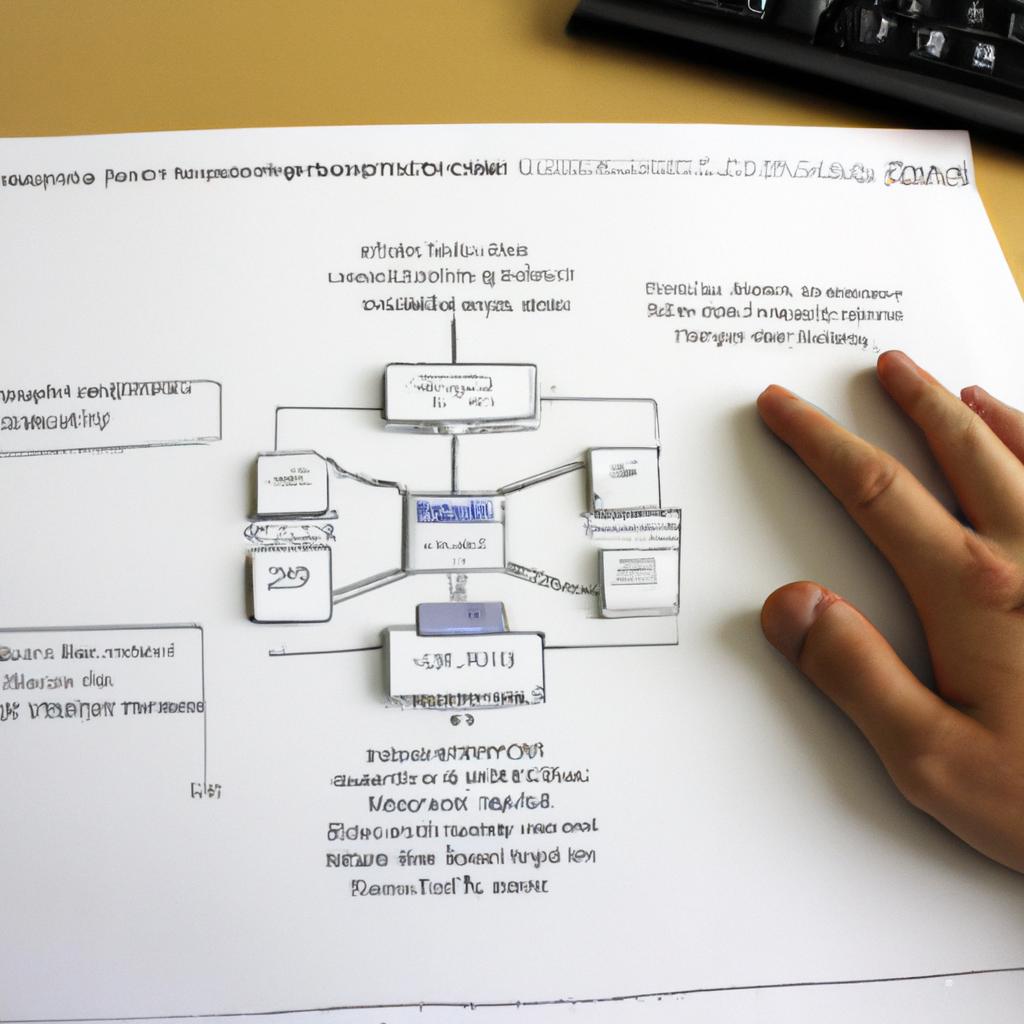Instruction Set Architecture: The Foundations of Computer and Hardware Architecture.
Instruction Set Architecture (ISA) serves as the fundamental framework upon which computer and hardware architecture are built. It provides a standardized set of instructions that dictate how software communicates with the underlying hardware, ensuring compatibility across different systems and enabling efficient execution of programs. For instance, consider a hypothetical scenario where an individual is using two different computers—one running on x86 architecture and the other on ARM architecture—to compile and execute a program written in C++. Despite their differing hardware implementations, the ability to write code that can be executed seamlessly on both machines is made possible by adhering to a common ISA.
In essence, Instruction Set Architecture acts as an intermediary layer between software and hardware, facilitating effective communication between these distinct components. This abstraction allows programmers to focus on developing high-level algorithms and applications without needing to concern themselves with low-level details of specific processors or memory hierarchies. By providing a clear set of rules for instruction formats, data types, addressing modes, and control flow mechanisms, ISAs enable software developers to write portable code that can run efficiently on various platforms.
Moreover, understanding the intricacies of Instruction Set Architectures is crucial not only for programmers but also for hardware designers. The design decisions made at this level have far-reaching implications for performance optimization, power efficiency and system design. Hardware designers need to carefully consider the trade-offs between different architectural choices, such as the number of registers, instruction formats, and memory organization, to ensure optimal performance and power efficiency.
Additionally, ISAs have evolved over time to accommodate advancements in technology and computing needs. New instructions and features are added to support emerging applications and enhance performance. For example, modern ISAs often include specialized instructions for multimedia processing, encryption/decryption, virtualization support, and parallelism (e.g., SIMD or vector operations). These extensions enable more efficient execution of specific tasks by leveraging hardware capabilities.
In summary, Instruction Set Architecture plays a vital role in bridging the gap between software and hardware. It provides a standardized interface that enables software developers to write portable code while allowing hardware designers to optimize performance and power efficiency. Understanding ISA concepts is essential for both programmers and hardware designers to develop efficient systems that meet the demands of modern computing.
What is an Instruction Set Architecture?
Imagine you are using a smartphone to send a text message. You type in the words and hit the send button, expecting your message to be delivered instantly. Have you ever wondered how this seemingly simple task actually takes place? Behind the scenes, there exists a set of instructions that enables your smartphone’s hardware components to perform specific tasks. This set of instructions forms what is known as an Instruction Set Architecture (ISA).
An ISA serves as the interface between software programs and computer hardware. It defines the repertoire of operations that a computer can execute and provides detailed specifications on how these operations should be executed. Just like a language allows humans to communicate with one another effectively, an ISA enables programmers to communicate with computers efficiently.
To better understand the significance of ISAs, consider the following points:
- Universal communication: An ISA creates a common language for all computer systems, allowing software developers to write code that can run on different types of hardware without modification.
- Efficient execution: By defining precise instructions and their corresponding formats, an ISA ensures that programs can be executed quickly and accurately by hardware components.
- Hardware compatibility: ISAs provide guidelines for designing compatible processors, allowing manufacturers to produce CPUs capable of executing programs written for a particular instruction set.
- Evolutionary flexibility: With new advancements in technology and changing computing needs, ISAs can evolve over time while maintaining backward compatibility, ensuring older programs continue to function correctly on newer architectures.
Table: Example Instructions in an Instruction Set
| Operation | Opcode | Operand 1 | Operand 2 |
|---|---|---|---|
| Add | 0000 | Register A | Register B |
| Subtract | 0001 | Register C | Immediate D |
| Multiply | 0010 | Register X | Memory Address |
| Divide | 0011 | Register Y | Immediate Z |
In summary, an Instruction Set Architecture forms the foundation of computer and hardware architecture. It enables software developers to write programs that can run on different types of hardware, ensures efficient execution of instructions by defining precise guidelines, promotes hardware compatibility, and allows for evolutionary flexibility in computing systems.
The next section will delve into the role played by Instruction Set Architectures in shaping computer design and functionality.
The Role of Instruction Set Architecture in Computer Design
Building upon the understanding of what an Instruction Set Architecture (ISA) entails, we can now delve into its crucial role in computer design and explore how it forms the foundation for hardware architecture.
To illustrate the significance of ISA in computer design, let’s consider a hypothetical scenario involving two popular processors – Processor A and Processor B. Both processors have different ISAs, which determine their instruction formats, supported operations, and addressing modes.
In comparing these two processors, it becomes evident that ISA plays a pivotal role in shaping various aspects of computer design:
-
Compatibility: The compatibility between software programs and hardware platforms is largely influenced by the underlying ISA. For instance, if a software program is developed specifically to run on Processor A with its unique set of instructions, it may not be compatible with Processor B due to differences in their respective ISAs. This highlights how ISA determines the extent to which software can seamlessly interact with a given hardware platform.
-
Performance Optimization: The choice of ISA affects performance optimization techniques employed during both software development and hardware implementation. Certain ISAs may offer specialized instructions or features designed to accelerate specific tasks or improve overall efficiency. By optimizing code execution through tailored instruction sets, developers can achieve enhanced performance within the constraints imposed by the chosen processor’s ISA.
-
Ease of Programming: The complexity and expressiveness of an ISA significantly impact developer productivity and ease of programming. An intuitive and well-designed ISA allows programmers to write concise yet powerful code while reducing potential errors or ambiguities. On the other hand, an overly complex or cumbersome ISA might hinder programmer comprehension and impede efficient utilization of available resources.
-
Flexibility and Future-proofing: As technology rapidly evolves, ISAs need to accommodate emerging requirements without sacrificing backward compatibility. A carefully crafted ISA provides flexibility for future enhancements while ensuring existing software investments remain relevant across generations of hardware architectures.
| Processor A | Processor B |
|---|---|
| Complex instruction set architecture (CISC) | Reduced instruction set architecture (RISC) |
| Multiple addressing modes and specialized instructions | Simpler, more standardized instruction formats |
| Emphasizes code density and reduced memory usage | Focuses on simplicity, facilitating pipelining and parallel execution |
In summary, Instruction Set Architecture plays a pivotal role in computer design by influencing compatibility, performance optimization, ease of programming, and future-proofing. By understanding the impact of ISA on hardware architecture, we can appreciate its significance in enabling efficient utilization of computing resources while fostering software-hardware synergy.
Understanding the various aspects associated with ISAs is crucial when exploring the components that comprise an Instruction Set Architecture. Let’s now delve into these components to gain a deeper insight into how they contribute to the overall functionality of ISAs.
Components of an Instruction Set Architecture
Section H2: The Foundations of Instruction Set Architecture
Building upon the understanding of the role of Instruction Set Architecture (ISA) in computer design, we will now delve into its components. By examining these key elements, we can gain a deeper appreciation for how ISAs form the foundation of computer and hardware architecture.
Components of an ISA:
-
Instructions: At the core of any ISA are instructions – sets of commands that dictate specific tasks for the processor to execute. These instructions encompass a wide range of operations, from arithmetic calculations to memory access and control flow. For example, consider a hypothetical instruction “ADD” which adds two numbers together within a register. This simple operation forms the basis for more complex computations performed by computers.
-
Registers: A crucial component of ISAs is registers – small storage units embedded within the processor itself. These high-speed memory locations hold data temporarily during computation, providing quick access to information needed for executing instructions efficiently. Registers serve as temporary storage spaces for input values, intermediate results, and output data throughout various stages of execution.
-
Addressing Modes: Another critical aspect of an ISA is addressing modes – mechanisms through which operands or data are specified within instructions. Different addressing modes allow flexibility in accessing different types and locations of data effectively. Examples include immediate mode (where the operand value is explicitly provided), direct mode (where the address points directly to the operand location), and indirect mode (where the address points to another address containing the actual operand).
-
Control Flow: Controlling program execution is essential in computer systems, and ISAs provide mechanisms to achieve this goal seamlessly. Branching instructions enable conditional jumps based on certain conditions being met or not met during program execution. Looping constructs like “FOR” or “WHILE” leverage branching instructions to repeat code sequences until specific conditions are satisfied.
- Enhances efficiency and performance
- Enables seamless multitasking
- Facilitates code portability and compatibility
- Supports diverse software applications
Emotional Table:
| Component | Purpose | Example |
|---|---|---|
| Instructions | Specify tasks for the processor to execute | ADD, SUBTRACT |
| Registers | Temporarily store data during computation | Accumulator, Program |
| Addressing Modes | Determine how operands or data are accessed | Immediate, Indirect |
| Control Flow | Enable conditional jumps and looping constructs | Branch, Loop |
Understanding these foundational components of ISAs provides a solid groundwork for exploring the various types of Instruction Set Architectures (ISAs) in the subsequent section.
Types of Instruction Set Architectures
Section H2: Instruction Set Architecture Evolution
Imagine a scenario where you are using your smartphone to launch a popular gaming app. As you tap on the icon, the app swiftly loads, and within seconds you find yourself immersed in an interactive virtual world. Behind this seemingly effortless experience lies the intricate workings of the instruction set architecture (ISA). In this section, we delve into the evolution of ISAs, tracing their development from early computer systems to modern-day processors.
Over time, ISAs have undergone significant advancements to meet the growing demands of complex computing tasks. To comprehend these developments better, let us explore some key factors that have influenced ISA evolution:
- Moore’s Law: This empirical observation by Gordon Moore states that the number of transistors on integrated circuits doubles approximately every two years. As transistor counts increased exponentially, ISAs had to adapt to exploit higher processing power efficiently.
- Application-Specific Demands: Different domains necessitate specialized functionalities from hardware architectures. For example, embedded systems require low-power consumption and real-time responsiveness, while high-performance computing relies on parallelization capabilities.
- Technological Advancements: The advent of new technologies has played a pivotal role in driving ISA evolution. Innovations like multi-core processors, pipelining techniques, and branch prediction mechanisms have significantly enhanced performance and efficiency.
- Performance-Portability Tradeoff: Designers face challenges in striking a balance between maximizing computational speed and maintaining compatibility across various platforms.
To gain further insight into the progression of ISAs over time, consider Table 1 below which presents notable examples highlighting different architectural features.
| Architecture | Key Feature | Advantages |
|---|---|---|
| Von Neumann | Single memory space | Simplicity |
| Reduced Instruction Set | Limited instruction set | Faster execution |
| Complex Instruction Set | Rich instruction set | Enhanced functionality |
| Superscalar | Multiple execution units | Increased performance |
As we can observe from the table, each architecture has its own unique characteristics and trade-offs. This demonstrates how ISAs have evolved to adapt to diverse requirements in terms of simplicity, speed, functionality, and performance.
Moving forward, the subsequent section on “Instruction Set Architecture Evolution” will delve into specific advancements that have shaped modern-day ISAs. By understanding this evolution, we gain a deeper appreciation for the intricate interplay between software and hardware components within computer systems.
Instruction Set Architecture Evolution
Imagine a scenario where two computers, with identical hardware specifications, are tasked with executing the same program. However, one computer significantly outperforms the other in terms of speed and efficiency. How is this possible? The answer lies in the design of their respective instruction set architectures (ISAs). ISAs play a crucial role in determining how efficiently a computer can execute instructions and ultimately influence overall system performance.
To better understand the impact of ISAs on computer performance, let us consider an example involving two popular ISAs – Reduced Instruction Set Computing (RISC) and Complex Instruction Set Computing (CISC). Suppose we have a RISC-based processor and a CISC-based processor, both running the same program that requires performing arithmetic operations, loading data from memory, and storing results back to memory.
A comparison between these two processors reveals several key differences:
- Instruction Complexity: CISC processors typically employ complex instructions that perform multiple tasks simultaneously, while RISC processors focus on simpler instructions that perform individual tasks.
- Hardware Utilization: Due to their complex nature, CISC instructions may require additional circuitry within the processor to handle various tasks. In contrast, RISC instructions tend to be more straightforward and utilize existing hardware components more efficiently.
- Pipeline Efficiency: RISC designs often feature shorter instruction cycles and uniform instruction formats, making them highly amenable to pipelining techniques. On the other hand, CISC processors may have longer instruction cycles due to their inherent complexity, hindering efficient pipelining.
The impact of these architectural differences is evident when examining real-world systems utilizing different ISAs. Consider the following hypothetical scenario comparing two computers:
| Attribute | RISC-Based System | CISC-Based System |
|---|---|---|
| Clock Speed | 3 GHz | 2.5 GHz |
| Number of Cycles | 1 billion | 1.5 billion |
| Instructions/Cycle | 2 | 1 |
| Total Executed | 2 billion instructions | 1.5 billion instructions |
| Execution Time | Approximately 0.67 seconds | Approximately 0.6 seconds |
From the above table, we can observe that despite the lower clock speed, the RISC-based system outperforms the CISC-based system due to its ability to execute multiple simpler instructions per cycle and utilize pipelining effectively.
In conclusion, instruction set architectures significantly impact computer performance by influencing factors such as instruction complexity, hardware utilization, and pipeline efficiency. The choice of ISA plays a crucial role in determining how efficiently a processor can execute instructions and ultimately affects overall system performance. In the subsequent section on “Importance of Instruction Set Architecture in Modern Computing,” we will explore further implications of ISAs and their relevance in contemporary computing systems.
Importance of Instruction Set Architecture in Modern Computing
Section H2: Instruction Set Architecture Evolution
Building upon the evolution of instruction set architecture, it is crucial to understand its significance in modern computing. By examining its role in enabling efficient and powerful hardware architectures, we can appreciate how instruction set architecture forms the foundation for computer systems.
The impact of instruction set architecture can be seen through an example that highlights its influence on performance and compatibility. Consider a hypothetical scenario where two processors are designed with different instruction sets – Processor A utilizes a complex instruction set architecture (CISC), while Processor B employs a reduced instruction set architecture (RISC). When executing a specific task, both processors achieve similar results; however, Processor B requires fewer instructions due to its simplified design. This reduction in complexity not only enhances efficiency but also enables faster execution times and reduces power consumption.
To delve further into the importance of instruction set architecture, let us explore four key reasons why it plays a vital role in modern computing:
- Compatibility: Instruction set architecture provides a standardized interface between software and hardware components. This standardization ensures that programs written for one system can run seamlessly on others with compatible architectures.
- Performance Optimization: The design choices made within an instruction set greatly impact processor performance. By carefully selecting operation types, addressing modes, and encoding formats, architects aim to maximize computational capabilities while minimizing resource utilization.
- Versatility: Instruction sets cater to various application domains by offering specialized instructions or extensions tailored to specific tasks such as multimedia processing or encryption algorithms. These domain-specific enhancements improve overall system versatility.
- Future Proofing: As technology advances at a rapid pace, new requirements emerge. Instruction sets need to evolve accordingly to support emerging technologies like artificial intelligence or quantum computing. Adaptable instruction sets allow for seamless integration of novel features without significant disruptions.
To summarize, understanding the foundations of computer and hardware architecture necessitates an exploration of instruction set architecture’s evolution and importance in modern computing. Through real-life examples and an examination of its impact on performance, compatibility, versatility, and future-proofing, we can grasp the pivotal role instruction set architecture plays in shaping computer systems.





